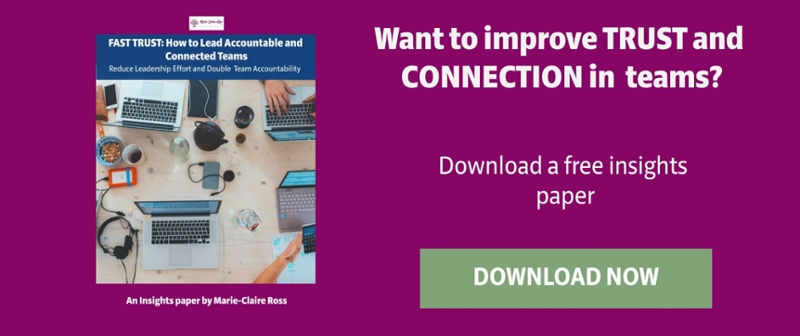
3 Common Workplace Issues that Highlight Trust is the Real Problem
According to the Hoffman Institute, 90% of our reactions are emotional. In fact, our emotions respond 400 times faster than our intellect.
People are led emotionally and rarely consciously think about who to trust. The part of the brain that processes emotions, including trust and loyalty, has no capacity for language. It only understands emotions. This means that when we trust someone using this part of our brain, we do so through how they make us feel, based on our old patterns, habits and biases. That’s why we often trust the wrong people because we do it through a gut feel, that’s based on faulty patterning.
In an organisational setting, trust is an emotional issue that often remains hidden because people find it hard to talk about and identify. Trust problems often go undiagnosed because they get confused with three common workplace issues that are essentially symptoms of trust issues. Unfortunately, these three symptoms get incorrectly treated as the problem resulting in a short-term solution that does little to impact the root cause.
-
Employee engagement issues
Often, when an organisation receives poor employee engagement results, the first action step is to fix engagement. This is approached in lots of different ways – from undertaking focus groups with employees, providing leadership training, supplying free food, undertaking team-building exercises and the list goes on.
The truth is engagement issues are only symptoms. The real issue is not disengagement or engagement. It’s distrust. Disengagement occurs when employees feel that they are not appreciated or trusted. It’s not safe for them to be themselves. Trust doesn’t cause engagement, it’s a pre-requisite for it. If you want engagement, you need trust first.
That’s why Great Places to Work Institute, after 20 years researching employee engagement worldwide, discovered that high levels of trust between managers and employees defines the best workplaces and drives overall company performance and revenue.
Leaders who have high engagement scores and deliver outstanding results don’t think to themselves, “how do I increase engagement today?” Instead, they focus on building trust with those around them.
Take Ali Rowghani. He’s had an amazing career working alongside Steve Jobs, Bob Iger (CEO, Disney), Ed Catmull (CEO, Pixar) and John Lasseter (Chief Creative Office, Pixar). His remark was that all of them were outstanding leaders with unique and very different leadership styles. But what they all had in common was that they all knew how to build trust with those around them. They encouraged people to contribute, voice their opinion and take control of their work. And they did it from the position of being engaged in their own work. After all, you can’t engage others if you’re fearful about the future, dislike the company and the products you create.
Leaders operating with trust enjoy higher engagement levels. They are intentional about building trust and they have learnt about it comprehensively so that they can more accurately build, judge and rely on trust with others. They also expect high trust behaviours from others ensuring that trust gets embedded into the company culture.
If you want to improve engagement issues, start by improving trust multi-directionally in your organisation. Don’t start from the incorrect belief that engagement is the problem.
2. Communication issues
Often, a common employee gripe highlighted in employee engagement surveys is poor communication. Employees are quick to complain that communication is unclear, they are the last ones to know what’s going on and that messages are inconsistent.
Again, the issue comes back down to the old, survival brain where we process trust and other emotions.
Employees can determine pretty easily whether they feel good or bad about their employer. But if you ask them specifically about what needs to be fixed – feelings lead the way. After all, 90% of our decisions are emotionally based. When we are asked to pinpoint or describe how to fix the problem, our brains have trouble deciphering our emotions, as that part of the brain can’t talk. So we come up with some plausible ideas that explain how we feel. Usually, we select broad concepts – communication happens to be one of them.
In the workplace, communication really needs to be more focused on reducing ambiguity and uncertainty. When people complain about communication issues, it’s because they suspect they are not being told the truth, not being told enough or it lacks clarity.
What people really want to know is what they need to do, how they need to do it, when, why and for who. In other words, clarity around decision-making authority, directives, expectations, deadlines all combined with regular feedback loops. Without the right context, people fear they will disappoint their boss or their job is at risk. They get confused and stuck. They focus on the wrong tasks. And they blame communication – when really no one has told them how they are expected to perform, what’s going on or what their responsibilities are within the organisation.
If leaders don’t dig deep enough to find out the basis of the communication problem, their knee-jerk reaction will be to spray everyone with irrelevant emails and to summon extra meetings.
Now, don’t get me wrong. communication is very important and trust is enabled through conversations and modelled through leadership behaviours. But it’s a very big word that can mean a lot of things. Never take communication issues at face value – undertake detective work to find out the real issues.
3. Resistance to Organizational Change Issues
According to a McKinsey study, 75% of change initiatives fail, often because the people aspect is overlooked or mismanaged. It doesn’t have to be this way.
The reality is that people are not only programmed to want to be together they’re also wired to seek challenges and novelty and explore their world.
Trust bears a close, inverse relationship with risk. The higher the stakes, the less likely people will trust the situation. Without trust, social groups become dysfunctional and start to break down. People become unwilling to cooperate resulting in slow decision-making, a lack of accountability, self-interested behaviours and difficulties meeting deadlines.
Our ability to commit to change is based on our belief that we can trust the leader or organisation to do the right thing by us and not make us vulnerable to loss in an uncertain situation.
As a leader, how you come across emotionally is essential, since 50-70% of the entire emotional state of an organisation is set by leaders.
Trust is enabled through conversations. Typically, when employees resist change it is because management has not comprehensively explained why change is necessary and how it is (or is not) beneficial. Actual change is quite frightening to the emotional brain that wants to keep us safe. Human beings need certainty.
Leaders need to know how to tap in and connect to deep subconscious patterning so as to get people to trust them and the organisation.
This means aligning employees’ self-interest to a more meaningful, bigger purpose set by the organisation. In other words, communicating the meaning behind work so that everyone collectively understands the goal they are all working towards, how their input matters and why the change is required. After all, humans need external goals, stimulation and feedback to feel good about themselves. People want to know the leaders visions of the future and see that reflected in their own aspirations. Otherwise, they feel frustrated confused and insecure about their role, which negatively impacts productivity.
Getting Past our Blind Spots
We can’t solve a problem if we don’t understand it. When the problem is people based, we need to understand the limitations of people’s ability to report what’s bugging them at work. Too often, organisations focus on symptoms and fail to address the real dysfunction. It means problems only get fixed at a superficial level resulting in it re-occurring in a few months time.
Even when executive leaders realise trust might be an issue, it’s difficult to know where to start and what to do. Trust is an emotional issue that is submerged from view. It’s really hard to see within your own company and it’s really difficult to fix on your own without the right blueprint or action plan.
And of course, you can’t improve it by asking “how can we build more trust?” The part of the brain that processes trust doesn’t understand words. That’s why getting an external consultant to uncover trust issues is much easier because they can see what’s right in front of you.
Lifting the lid on trust might seem a bit confronting, but it’s the quickest way to get everyone aligned to meet your goals.

